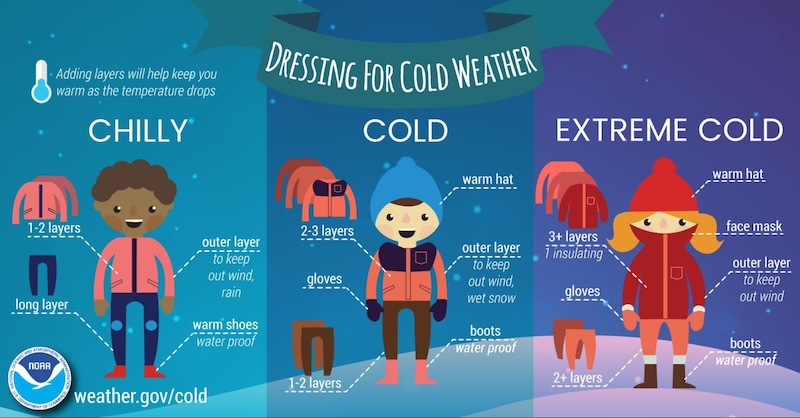Bundling up and staying dry are two of the best things you can do to stay safe from cold temperatures this fall and winter.

Dressing appropriately for cold weather is essential to stay warm and comfortable. Here are some tips on how to dress for the cold:
- Layering:
- Base Layer: Start with a moisture-wicking base layer to keep sweat away from your body. Materials like polyester or merino wool work well.
- Insulating Layer: Add an insulating layer for warmth. Fleece or down jackets are excellent choices.
- Outer Layer: Wear a waterproof and windproof outer layer to protect against rain, snow, and wind.
- Insulated Outerwear:
- Choose a good-quality winter coat or jacket with insulation to retain body heat. Look for features like a high collar and a hood for added protection.
- Headgear:
- Wear a hat to prevent heat loss from your head. A substantial portion of your body’s heat can escape through your head.
- A scarf or neck gaiter can help protect your neck and face from cold winds.
- Gloves or Mittens:
- Cold hands can be uncomfortable, so invest in insulated and waterproof gloves or mittens.
- Footwear:
- Wear waterproof and insulated boots to keep your feet warm and dry. Make sure they have good traction to avoid slipping on icy surfaces.
- Thermal Socks:
- Choose thermal or wool socks to keep your feet warm. Layering socks can provide additional insulation.
- Pants:
- Wear insulated pants or layer with thermal leggings underneath for added warmth.
- Accessories:
- Consider wearing thermal underwear for extra warmth.
- Hand and foot warmers can be added for extreme cold conditions.
- Sunglasses can protect your eyes from harsh winter sunlight and wind.
- Stay Dry:
- Keep moisture away from your body. Wet clothing can significantly increase heat loss. Use waterproof outer layers and avoid prolonged exposure to rain or snow.
- Adjust Layers:
- Be prepared to adjust your layers based on the activity level and changing weather conditions.
- Check the Weather:
- Check the weather forecast before heading out and dress accordingly. Different temperatures, wind, and precipitation levels may require different clothing combinations.
Remember that personal comfort varies, so adjust your clothing based on your activity level, the duration of exposure to the cold, and your own sensitivity to low temperatures. It’s better to be slightly overdressed than underdressed in extremely cold conditions.